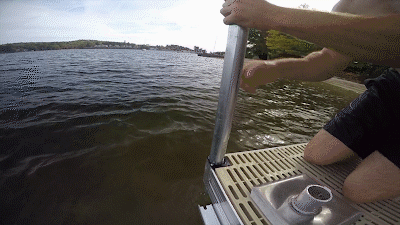This question keeps coming up on my youtube video about 4×4 post docks. I decided to elaborate on the topic because so many people ask the same question.
I’d like to start by saying, maybe a floating dock is a better option for you if you have a sinking problem in soft soil or ground. I remember two locations were I was able to push a pipe into the lake bed 7′ before reaching firm soil. That would become a problem with stability and attaching the proper diagonal bracing beneath the mud. Seven feet is getting close to the maximum height you want for your dock on legs. The only other stable option for a dock 10′ or higher on legs would be to use pilings driven by heavy machinery. Not all locations are ideal for heavy machinery so the modular docks that can be hand lifted are what work best in remote locations.
When asked what keeps the 4×4 post from sinking. The answer is “the Post foot”. Try pushing the 4×4 into the ground, then sharpen the end and try again. If you have the right soil you will realize it’s not that easy and you may not need the feet on harder ground. Use a hose next to it to move the soil away. This is called “water jetting”. If doing this your hair gets filled with muck and plants, stop now and consider a floating dock; but anyway, a stationary dock should be held level while installing the legs so the legs are plum once complete. A sledge hammer and 4×4 post driving cap is used to pound the post into the ground. The foot keeps the post from sinking as long as the soil is firm. A bottomless sawdust pond near a mill, thick mossy vegetation or mud you find with clams may be too soft for legs with feet. Do your own feet sink out of site? I would suggest poking a leg in before you purchase all of your stationary dock hardware. These silty locations are often low wind so ideal for a floating dock anyway. The floating dock will not be as messy during install or removal. Simply float them out, bolt them together and attach the anchoring.
 On wood docks, pipe leg and hardware is similar in cost to the 4×4 post legs and hardware but the steel inch and a half schedule 40 galvanized pipe is heavy and pokes into the ground easier. Once again, “the Pipe foot” keeps it from sinking in the ground as long as it isn’t quicksand you’re putting a dock in and the pipes are driven with a sledge hammer and pipe driving cap. The same pipe and pipe foot is used in Great Northern Docks popular Stationary DuraLITE and FeatherLITE Aluminum docks all around the world. The pipe size 1.5″ schedule 40 is an industry standard and fit’s all of Great Northern Docks stationary pipe docks and DIY pipe dock hardware.
On wood docks, pipe leg and hardware is similar in cost to the 4×4 post legs and hardware but the steel inch and a half schedule 40 galvanized pipe is heavy and pokes into the ground easier. Once again, “the Pipe foot” keeps it from sinking in the ground as long as it isn’t quicksand you’re putting a dock in and the pipes are driven with a sledge hammer and pipe driving cap. The same pipe and pipe foot is used in Great Northern Docks popular Stationary DuraLITE and FeatherLITE Aluminum docks all around the world. The pipe size 1.5″ schedule 40 is an industry standard and fit’s all of Great Northern Docks stationary pipe docks and DIY pipe dock hardware.
Docks with wheel kits are best used on firm soil so the wheel doesn’t get stuck in the mud. Trying to roll a dock out of the mud with wheels on the legs could break the perpendicular legs or dock frame if the wheels are stuck in mud.
Boat lifts have feet but are not ideal in muck where they would tilt out of level and settle to no end.
If you learn that your soil is too soft and your investment is sinking don’t pull the legs sideways with a truck to get them out because 9 times out of 10 they will bend or break; instead, try floating or jacking straight up and try the water jetting at the same time to release the suction.
Once you get it out in one piece, sell it and get a floating dock.
Every location can be a challenge. One way to know what works best is to look around at what the neighbors have and determine if those docks are in a similar environment.
When you dream of having a dock, look around for the best location.
The dock location is the reason one is used and not the other.









